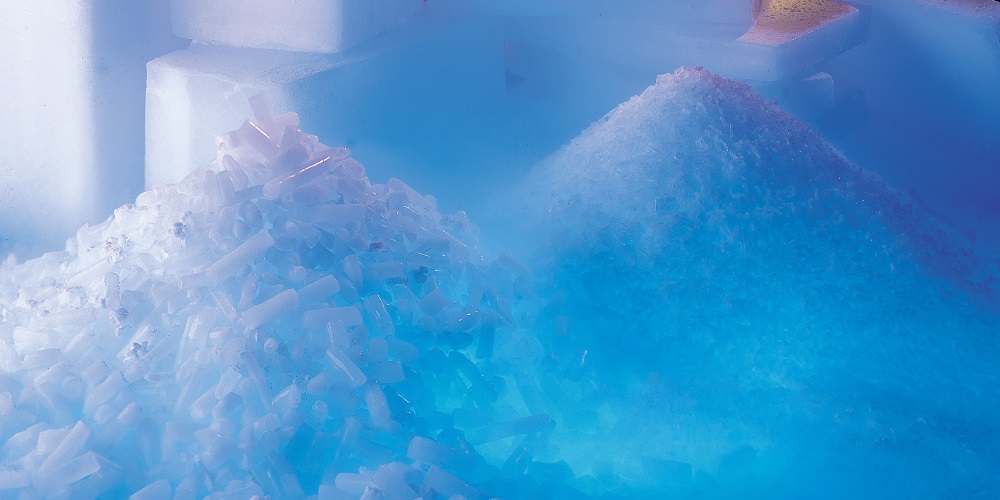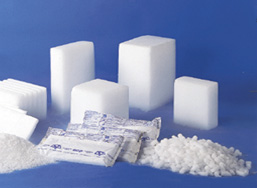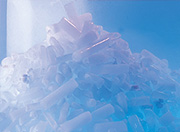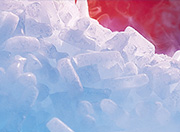
What is dry ice
 Dry ice (Carboglace®), in other words CO2 in the solid form, is obtained by means of liquid CO2 expansion at Earth atmospheric pressure. One half of the liquid CO2 vaporizes and the other half solidifies into CO2 snow. The CO2 snow is compressed in high pressure hydraulic presses or extruder machines into blocks or pellets of dry ice with the respective diameters of 3 mm and 16 mm. Dry ice is a completely natural product.
Dry ice (Carboglace®), in other words CO2 in the solid form, is obtained by means of liquid CO2 expansion at Earth atmospheric pressure. One half of the liquid CO2 vaporizes and the other half solidifies into CO2 snow. The CO2 snow is compressed in high pressure hydraulic presses or extruder machines into blocks or pellets of dry ice with the respective diameters of 3 mm and 16 mm. Dry ice is a completely natural product.
One property of dry ice is sublimation, i.e. the transition from the solid to the gas phase at Earth atmospheric pressure with the omission of the liquid phase. Hence the name: Dry Ice. Moreover, dry ice generates bacteriostatic atmosphere which improves the quality of the cooled products preventing their oxidation.
 Dry ice pellets of 3mm in diameter
Dry ice pellets of 3mm in diameter
The dry ice pellets of Φ 3mm are used mainly by food manufacturers, who add it to minced meat, spices or dough as food additive E290. The Φ 3mm pellets resemble rice grains. Moreover, they are used for dry ice cleaning machines.
 Dry ice pellets of 16mm in diameter
Dry ice pellets of 16mm in diameter
The dry ice pellets of Φ 3mm are the most frequently used form of dry ice, whose properties enable them to gradually substitute dry ice in the form of blocks. They are used mainly by such businesses as: food manufacturers, transport companies, industrial manufacturers, steel mills. It is also used for special effects in the film industry, at laboratories and by catering businesses.
Dry ice properties:
- natural product
- environment friendly
- sublimation to the gas phase without any residue
- no investment costs
- no cost related to the electric energy
- temperature of -78.5 °C
- odourless
- cooling twice as effective as with the use of wet ice
- specific density: 1.56 kg/dm3 – heavier than air, falls to the ground
- tasteless
- non-combustible
- non-toxic
Dry ice is available on a current basis with the option of delivery to any location in Poland.
Dry ice – safety precautions
Dry ice is a completely natural product. One property of dry ice is sublimation, i.e. the transition from the solid to the gas phase at Earth atmospheric pressure with the omission of the liquid phase. Hence the name: Dry Ice.
Download the Health and Safety Instruction for Working with Dry Ice in pdf format.
Health and Safety Instruction for Working with Dry Ice
I. Dry ice properties
Dry ice is a completely natural product. One property of dry ice is sublimation, i.e. the transition from the solid to the gas phase at Earth atmospheric pressure with the omission of the liquid phase. Hence the name: Dry Ice. Dy ice generates bacteriostatic atmosphere which improves the quality of the cooled products preventing their oxidation. Dry ice is a non-combustible, odourless, tasteless, non-toxic and authorised food contact material. Carbon dioxide is heavier than air and therefore its concentration is highest at the ground. If in high concentration, especially in small closed rooms, it may cause asphyxia. Containers with dry ice and the dry ice itself must be kept out of reach of children and animals.
II. Hazards
- The direct contact with carbon dioxide (CO2) in the solid form may cause frostbite (the temperature of dry ice is -78°C).
- During sublimation dry ice displaces oxygen from the air. The volume of CO2 in the air exceeding 5% is a hazard. It may cause nausea, weariness and loss of consciousness. Very high concentration of carbon dioxide may lead to asphyxia.
- As the dry ice sublimes in a sealed container, the pressure build-up may cause the container to burst. This is why dry ice may be stored only in containers designated for this type of product or in the containers in which it was delivered.
III. Safety precautions
- Dry ice must not be touched with bare hands. A person handling dry ice must be equipped with safety goggles, a safety mask, insulated safety gloves.
- Dry ice has nothing in common with ice cream. It is not designated for direct consumption. It must not be eaten or used to cool drinks. Dry ice is an industrial coolant.
- Follow the rule: open the container with dry ice for the shortest period of time necessary and reduce the amount of time spent directly next to the container.
- After you place a product in a container with dry ice, close the lid and seal the container.
- It is important that dry ice is not stored in a fully sealed container not designated for this purpose as it may, due to its properties, cause the container to burst, which may constitute a life or health hazard.
- Containers with dry ice and the dry ice itself must be kept out of reach of children and animals.
IV. Individual and collective safety precautions
- When performing any activities connected with the opening of the container with dry ice or putting dry ice into or taking it out of the container, the following must be used at all times:
- safety goggles, safety mask, insulated safety gloves,
- clothing and footwear as prescribed in the clothing table for cold store workers.
- Safety goggles must be used during the cleaning of containers.
- Containers with dry ice and the dry ice itself must be kept out of reach of children and animals.
V. Proceeding in hazardous situations
- If the CO2 sensor goes off, the room must be left and ventilated.
- To extinguish any fire around the containers with dry ice use the fire extinguisher available on site.
VI. FIRST AID
The following treatment needs to be applied after direct contact with dry ice:
- Contact with skin:
- Soak the frostbite in lukewarm water for around 15 minutes,
- cover the skin with antiseptic dressing and seek medical help.
- Contact with eyes:
- the painful and badly healing frost bites may cause irrevocable damage to the eyes;
- Rinse the eyes with lukewarm water immediately after contact with dry ice,
continue for 15 minutes. - Cover the eyes with antiseptic sterile dressing.
- Seek immediate ophthalmologist help.
- Inhalation – if a person develops the following symptoms:
- increased respiratory rate,
- headache,
- Inability to move,
- unconsciousness,
take the person outside, to a quiet place and provide them with warm cover. Seek medical help. Where there is no breath, perform artificial respiration.
- Choking:
avoid by all means. In the event of choking immediately seek medical help. - Consumption:
NEVER swallow. Swallowing dry ice may lead to serious injuries of the internal organs. Provide medical help immediately.
VII. Disposal
- If necessary, dispose of dry ice on open space leaving it to sublimate entirely; prevent the access of third parties.
- Do not put dry ice into sewer systems, cellars, shafts or any similar places where it could condensate to a dangerous level.
- Contact your dry ice supplier whenever necessary.
